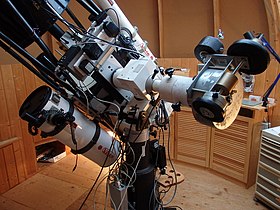Counterweight (astronomy)
In astronomy, a counterweight is an object that balances the load of the telescope on the opposite side on an equatorial mount . It is therefore a special case of the counterweight dealt with in the article Counterweight (mechanics) .
Counterweights usually have the shape of a cylinder or disk and must be matched to the respective mount. They are therefore available in different sizes or dimensions and with different hole diameters. For amateur telescopes , they usually weigh between 1 and 10 kg, while large lens telescopes in observatories can take several 100 kg. Since the counterweights must fit on the counterweight rod and should be freely movable on it, the diameter of the central bore must be slightly larger than the rod diameter. The counterweight is held by a clamping screw.
First the empty mount is aligned towards the celestial pole , then the weights are loaded and fixed close to the right ascension axis . Finally, the telescope is mounted as the main weight. The system is brought into equilibrium by bringing the right ascension axis into a horizontal position and the clamping remains released, but held by the operator. Now the weights on the counterweight bar are slowly pushed outwards until an equilibrium is established. The further out there is a counterweight, the more unstable the mount becomes and the easier it begins to swing. One or two heavy weights near the main axis are therefore cheaper than light weights at the end of the counterweight rod. The information on the weight of the permissible load of a mount refers exclusively to the loads on the instrument side. How many counterweights are then added does not matter and is already taken into account in the invoice. The specification "max. 20 kg" only refers to the instruments. In addition to this 20 kg weight, there are also between 15 and 20 kg counterweights.
At the lower end of the counterweight rod there is a safety screw that prevents a counterweight that is accidentally too loosely clamped from sliding off the mount and falling to the ground. The sudden excess weight on the telescope side would otherwise loosen the clamp on the mount and swing the telescope tube to the lowest point and hit the column or the tripod legs. If the counterweight slips against the locking screw instead, the telescope will at most straighten up. In both cases, however, a new entry of the reference stars is required for a Goto mount .
Barrel weight
A barrel weight is also a counterweight, but it is located on the telescope tube. In the picture it is the silver cylinder on the orange rail. The barrel weight is provided with a clamp and can be moved on the mounting rail of the telescope tube. It is used when the telescope has eyepieces of different weights or other accessories such as B. a camera for astrophotography can be attached and removed. With the running weight, these load changes on the declination axis are compensated for. However, since the total weight of the telescope side changes as a result of the conversion, the counterweight must then be readjusted.
Self-made
Many amateur astronomers build their own telescope mounts. Panes cast from lead are particularly suitable as counterweights because they are easy to manufacture and do not take up a large volume due to the high density of the material. They can be poured into old cans that are peeled off after cooling. Before the casting, the axis is brought in centrally, and a screw + nut cast in can serve as a future clamp.
literature
- Albert G. Ingalls: Amateur Telescope Making , 568 p., Willmann-Bell 1996
- W. Jahn: The optical observation instruments, pp 9-79 in the handbook for star friends , Springer-Verlag 1981
- Rudolf Brandt : The telescope of the star friend . Kosmos-Verlag, Stuttgart 1958

